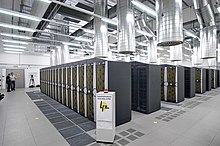High performance computer Bavaria II
| Surname | HLRB 2 |
|---|---|
| R peak | 62.3 T FLOPS |
| R max | 56.5 TFLOPS |
| Processor cores | 9728 |
| Main memory | 39 TB |
| Manufacturer | SGI |
The Bayern II high-performance computer, HLRB II for short , was a supercomputer that was operated in the new Leibniz computing center in Garching near Munich . The computer was a Silicon Graphics system based on the Altix 4700 platform. It was put into operation on July 21, 2006. In June 2011, the HLRB II was in the list of the 500 fastest supercomputers in 15th place among German computers and ranked 198th worldwide.
In the expansion phase 1 it had 4096 processors with a peak performance ( Rpeak ) of 26.2 Tera - FLOPS . Intel processors of the Itanium 2 Madison 9M type with 1.6 GHz were used as processors . The operating system used was SUSE Linux Enterprise Server 10.
In April 2007, in the course of the second expansion stage, the processors were replaced by the Itanium 2 Montecito Dual Core type, the computer thus had 9728 processor cores and achieved a peak performance of 62.3 Tera-FLOPS. It also had 39 TB of main memory, and the storage area network was expanded to 600 TB.
The acquisition costs were around 38 million euros and were borne by the federal government and the Free State of Bavaria . The Free State of Bavaria alone bore the operating costs of around 3 million euros per year.
The entire system weighed 103 tons and required approx. 1.1 MW of electrical power at full load.
In July 2009 it was decided to expand the data center with a second high-performance computer, the SuperMUC . A second, also cube-shaped building was built directly on the HLRB II, completed in 2006, in which the computer was installed. The cost of the expansion was supposed to be 135 million euros and was borne by the federal government and the Free State of Bavaria. Construction was completed in spring 2011. The HLRB II had been completely dismantled by the time the SuperMUC was officially opened in July 2012.
The main applications of the computer are large eddy simulation , Lattice Boltzmann application , quantum chromodynamics , astrophysics , high energy physics and quantum chemistry .
swell
- ↑ Specification of the LRZ Munich . Archived from the original on February 1, 2009. Retrieved January 21, 2013.
- ↑ TOP500 list June 2011 . Retrieved January 21, 2013.
- ↑ Extension of the LRZ building . Retrieved January 21, 2013.
Web links
- New German supercomputer in operation . Retrieved January 21, 2013.

